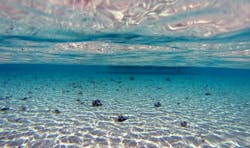Analyzing data from thousands of floating sensors is goal in second phase of DARPA Ocean of Things project
ARLINGTON, Va. – U.S. military researchers are asking the defense industry to analyze and refine data from thousands of floating sensors in the ocean to create actionable intelligence to help Navy commanders carry out their missions at sea.
Officials of the U.S. Defense Advanced Research Projects Agency (DARPA) in Arlington, Va., issued a broad agency announcement on Tuesday (HR001120S0042) for the second phase of the Ocean of Things project.
This project, first announced in late 2017, seeks to develop persistent, wide-area sensor surveillance across large ocean areas using large numbers of intelligent floats or buoys.
The solicitation announced this week focuses on the analytics portion of the Ocean of Things project. DARPA wants companies to develop analytical techniques to distil insights from an autonomous float field and produce mission products from many concise float data reports. Several contract awards are expected collectively worth as much as $8 million.
While the Ocean of Things program aims at affordable ocean sensing at large scales and high resolution, the project's analytics portion seeks to provide detailed understanding of the ocean environment to protect natural resources and enable the military to operate more effectively on the high seas.
The Ocean of Things program provides environmental sensing and operational surveillance missions by composing data from a distribution of heterogeneous floats. Each float characterizes the physical environment through periodic sampling of local ocean properties, while also reporting significant maritime events.
A primary objective is to develop edge-processing methods to identify and report essential information from any events within a float’s range to enable mission analysis once the data reaches the cloud. This project also will help choose sensors and sampling rates to make the most of system performance.
Ultimately DARPA researchers envision a field of smart sensors housed on as many as 50,000 floats to cover vast ocean areas as large as one million square kilometers.
Those participating in the program's data analytics section should apply advanced processing techniques like filtering, clustering, and machine learning to develop vessel tracks, characterize vessel behaviors, identify new signatures, and conduct other mission analytics.
Related: The role of technology in securing the nation’s borders
The project also will visualize float sensor coverage, predict float field performance, and control individual floats to maintain a floating sensor field comprising thousands of floats.
The second phase of the Ocean of Things project has two technical areas: design and production of floats; and developing advanced data analytics to generate mission products. This announcement only involves data analytics.
For Ocean of Things analytics, DARPA is looking for companies to mine the data cloud filled by these floats to deliver smart inferences about the sea state, upwellings, currents and winds based on float motion, and track- generating algorithms or oil spill drift predictions.
Companies should be able to apply sophisticated software and algorithms to float data, which will include sea surface and air temperature, acoustic ambient noises, wind speed, wave dynamics, and float motion to help generate vessel tracks, multi-spectral vessel signatures, and vessel behavior.
Related: Intelligence experts approach industry for UUV networks for covert surveillance of shipping
During the Ocean of Things first phase, companies developed user interfaces computers to analyze data sets for several small float deployments in Southern California and the Gulf of Mexico. In the second phase, performers will use an existing user interface, advanced algorithms, and analytic techniques to analyze all data.
In the second phase, companies will work closely with existing float designers during software design and testing.
Building the capabilities envisioned in the Ocean of Things project is important because today's naval and commercial ships typically can use only their onboard sensors for situational awareness. Using remote sensors from aircraft and satellites, moreover, can be limited or impossible because of fog, rain, cloud cover, and other environmental conditions.
The smart float system in the Ocean of Things program will use a cloud-based architecture, find ways to visualize the dynamic capabilities of the system, and find new ways for operators to interact with large numbers of floats.
Companies interested should upload proposals no later than 15 May 2020 at https://baa.darpa.mil. Email questions or concerns to DARPA at [email protected].
More information is online at https://beta.sam.gov/opp/37991fec08e949db80f9e3185d1a319b/view.
About the Author
John Keller
Editor-in-Chief
John Keller is the Editor-in-Chief, Military & Aerospace Electronics Magazine--provides extensive coverage and analysis of enabling electronics and optoelectronic technologies in military, space and commercial aviation applications. John has been a member of the Military & Aerospace Electronics staff since 1989 and chief editor since 1995.
